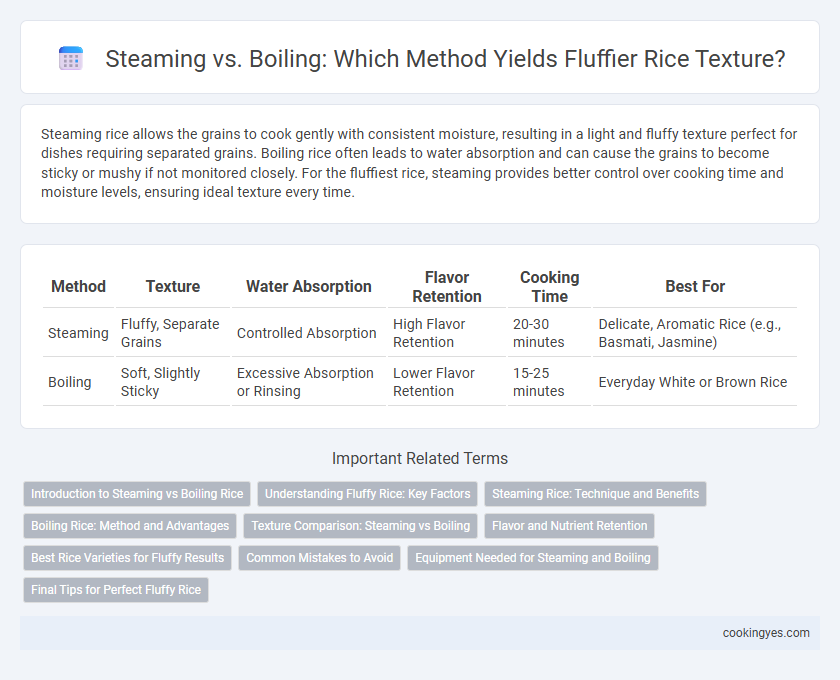Steaming rice allows the grains to cook gently with consistent moisture, resulting in a light and fluffy texture perfect for dishes requiring separated grains. Boiling rice often leads to water absorption and can cause the grains to become sticky or mushy if not monitored closely. For the fluffiest rice, steaming provides better control over cooking time and moisture levels, ensuring ideal texture every time.
Table of Comparison
| Method | Texture | Water Absorption | Flavor Retention | Cooking Time | Best For |
|---|---|---|---|---|---|
| Steaming | Fluffy, Separate Grains | Controlled Absorption | High Flavor Retention | 20-30 minutes | Delicate, Aromatic Rice (e.g., Basmati, Jasmine) |
| Boiling | Soft, Slightly Sticky | Excessive Absorption or Rinsing | Lower Flavor Retention | 15-25 minutes | Everyday White or Brown Rice |
Introduction to Steaming vs Boiling Rice
Steaming rice preserves individual grain integrity and enhances fluffiness by gently cooking with moist heat, preventing waterlogging. Boiling submerges rice completely, often resulting in softer, sometimes mushy grains due to excess water absorption. Understanding these methods aids in achieving the ideal fluffy texture preferred in various culinary traditions.
Understanding Fluffy Rice: Key Factors
Steaming rice retains more moisture and prevents nutrient loss, resulting in a fluffier texture by allowing each grain to absorb steam evenly without becoming waterlogged. Boiling can lead to overhydration and stickiness if the water-to-rice ratio and timing are not carefully controlled, often causing grains to clump together. Optimal fluffy rice depends on choosing steaming methods that maintain individual grain integrity and proper hydration levels.
Steaming Rice: Technique and Benefits
Steaming rice preserves its natural texture by cooking grains evenly with gentle steam heat, preventing water absorption that leads to mushiness. This method maintains the rice's structural integrity, resulting in a fluffy, separate grain consistency ideal for dishes like biryani or sushi. Steaming also retains more nutrients compared to boiling, enhancing the rice's flavor and nutritional profile.
Boiling Rice: Method and Advantages
Boiling rice involves immersing grains in a large amount of water until fully cooked, then draining the excess water, which helps remove excess starch for a fluffier texture. This method offers consistent heat distribution, reducing the risk of uneven cooking and clumping. Compared to steaming, boiling ensures a lighter, separate grain outcome ideal for dishes requiring distinct rice grains.
Texture Comparison: Steaming vs Boiling
Steaming rice preserves individual grain integrity, producing a light, fluffy texture with minimal starch loss. Boiling causes grains to absorb more water, often leading to a softer, sometimes stickier texture due to starch release into the cooking water. Steaming maintains structural firmness, while boiling can result in a more cohesive, less separated rice grain profile.
Flavor and Nutrient Retention
Steaming rice preserves its natural flavor and nutrient content better than boiling because the grains absorb water vapor rather than submerging in water that can leach out vitamins and minerals. The gentle steam heat ensures a fluffy texture by evenly cooking each grain without excess moisture, preventing mushiness. This method retains more vitamins like B-complex and minerals essential for a nutritious, flavorful meal.
Best Rice Varieties for Fluffy Results
Long-grain rice varieties like Basmati and Jasmine are ideal for achieving a fluffy texture due to their lower starch content and firm grains. Steaming enhances the fluffiness by gently cooking rice without excess water absorption, preventing clumping typical in boiling. Medium-grain varieties such as Calrose offer a slightly stickier texture but can still be fluffy when steamed properly, making them versatile options for various dishes.
Common Mistakes to Avoid
Overcooking rice by boiling too long causes mushy texture and nutrient loss, while insufficient water leads to undercooked grains when steaming. Avoid stirring rice during cooking as it releases starch and results in clumping, compromising fluffiness. Using the correct water-to-rice ratio, typically 1.5 to 2 cups of water per cup of rice, ensures optimal absorption for light, separate grains.
Equipment Needed for Steaming and Boiling
Steaming rice requires a steamer basket or an electric rice cooker with a steaming function to ensure even heat distribution and moisture retention for a fluffy texture. Boiling rice needs a pot with a tight-fitting lid to control water evaporation and prevent overcooking while maintaining the grains' integrity. Proper equipment choice directly impacts the rice's fluffiness by managing heat and moisture effectively during cooking.
Final Tips for Perfect Fluffy Rice
For perfectly fluffy rice, choose steaming over boiling as steaming retains more moisture, preventing soggy grains and ensuring each grain remains separate. Use the correct water-to-rice ratio, typically 1.5 to 1.75 cups of water per cup of long-grain rice, to avoid excess water absorption that causes clumping. Allow the rice to rest covered off heat for 10 minutes after cooking, which helps the grains firm up and enhances the fluffy texture.
Steaming vs Boiling for fluffy texture Infographic

 cookingyes.com
cookingyes.com